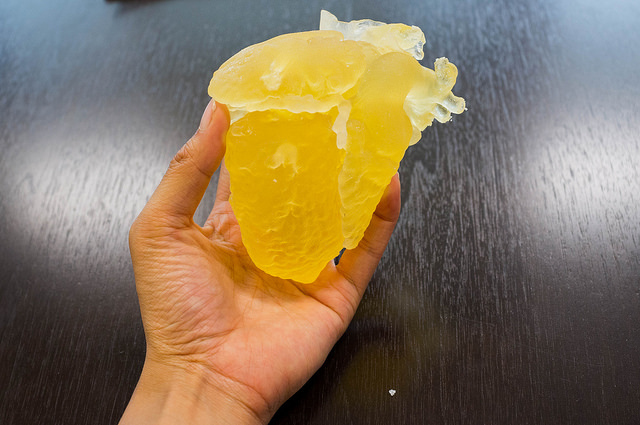
0
0
1
67
387
TDC
3
1
453
14.0
Normal
0
false
false
false
EN-US
JA
X-NONE
/* Style Definitions */
table.MsoNormalTable
{mso-style-name:”Table Normal”;
mso-tstyle-rowband-size:0;
mso-tstyle-colband-size:0;
mso-style-noshow:yes;
mso-style-priority:99;
mso-style-parent:””;
mso-padding-alt:0cm 5.4pt 0cm 5.4pt;
mso-para-margin-top:0cm;
mso-para-margin-right:0cm;
mso-para-margin-bottom:8.0pt;
mso-para-margin-left:0cm;
line-height:107%;
mso-pagination:widow-orphan;
font-size:11.0pt;
font-family:Calibri;
mso-ascii-font-family:Calibri;
mso-ascii-theme-font:minor-latin;
mso-hansi-font-family:Calibri;
mso-hansi-theme-font:minor-latin;}
SP16_TEAMFacility_KL-2422 licensed under CC BY 2.0
The technology of 3D printing is developing rapidly and has enabled many innovations across various industries.
The applications for 3D printing in the medical industry highlight the technology’s transformative power more clearly than those in other industries while promising to impact the lives of millions of patients.
Recent groundbreaking achievements will soon transform the medical industry and change the lives of many patients. Here are some of the latest advancements in the medical industry that are shaping the future of medicine.
Embryonic Stem Cells
Scientists have developed the ability to mix embryonic stem cells with hydrogel, thus creating embryoid bodies. Until now, 3D-printed stem cells were produced in single layers that often lead to unpredictable results. The technology is now so advanced that it enables scientists to print stem cells in a six-layered grid-like 3D structure.
This 3D bioprinting technology will have incredible capabilities once it is perfected. Doctors and other medical professionals will be able to use 3D outputs to grow tissue and organs that will help patients heal faster and better than ever.
Vascular Networks
One of the biggest challenges in bioprinting is producing blood vessels capable of carrying oxygen to 3D printed stem cells. Tissue that grows thicker than 200 micrometers requires oxygen to survive, so recent medical uses of 3D printing have been quite limited.
However, scientists have created a bioprinter capable of 3D printing blood vessels. It can construct a complex network of blood vessels that is able of carrying blood flow to living tissue. The discovery of this technology is a crucial component that will enable 3D printing of vital organs.
Vital Organs
3D printed organs such as ears and noses are already being created. However, it will take some time before scientists are able to create fully functional complex organs such as the heart. Once 3D printed stem cells and vascular networks are fused together to create working organs, bioprinting will take medicine to a completely new level. This will boost the number of transplant options available to thousands of patients.
Computer modeling and other technologies must become perfected before such body parts become available for general use, but researchers have already managed to produce small livers and kidneys that can stay viable for as long as four months.
Achieving incremental gains in the race to develop 3D printed organs has helped scientists to develop new techniques that will soon result in a steady supply of customized transplantable organs that might save as many as 300,000 lives every year.
Synthetic Skin
L’Oreal already grows skin samples from donated skin tissue. However, the existing methods require a lot of time and labor. To automate the development of synthetic skin using 3D printing technology, L’Oreal has partnered with the researchers at Organovo.
The bioprinting platform they have developed isolates skin cells and multiplies them. Before putting them in the 3D printer, they are kept in a medium with oxygen and nutrients. Skin can then be printed layer by layer.
As a result of the recent breakthroughs, the cost of synthetic skin will decrease while its quality will increase. 3D printed skin already provides a framework for testing the effects of cosmetics on human skin. When perfected, the technology will completely eliminate the need for testing cosmetics on animals while allowing access to cosmetic products without any harsh side effects.
Customized Drugs
In general production, one of the biggest advantages of 3D printing is the ability to create various customized items. This customization can also be applied to producing medicine that is specially designed to meet the needs of particular patients.
Pharmaceutical companies attempt to meet the needs of diverse patients by manufacturing drugs that contain varying amounts of medications and use different delivery modes. As a result, patients don’t always get the dosages of drugs that work best for them, but that will soon change.
New 3D printing developments promise to open the door to the use of customized drugs that will meet the exact needs of a patient’s body, regardless of whether they have cancer or the flu.
Growing Bones and Cartilage
Broken bones requires a lengthy process of repairing it and reconstructing it to its original condition. Medical companies have already developed ways to produce bone replacements from materials such as titanium and PEKK plastic. Now, researchers have turned their focus on the use of 3D printing to create bones that have an outer casing made from calcium phosphate. Being a natural component of bones, this mineral will reduce the possibility of rejection or infection.
New polymers such as hydrogel aid the generation of bone and cartilage and have paved the way to research that will result in the creation of full bones and joints using 3D printing technology. So far, printed cartilage cells have created larger tissue samples than expected, suggesting that revolutionary bone products will soon reach the market.
Conclusion
3D printing has already revolutionized many industries, but soon, the technology might save numerous patients’ lives. People will soon depend on medical 3D printing to give their bodies everything they need from medicine to new joints. Although much of the necessary technology has not yet been perfected, 3D printing has already demonstrated that it will forever change the medical industry.

